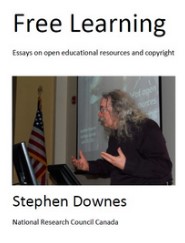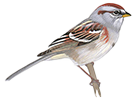Remember when people told you "what's online is forever?" Well, according to this Pew report, "A quarter of all webpages that existed at one point between 2013 and 2023 are no longer accessible." I have no reason to doubt that, based on my own experience. "23% of news webpages contain at least one broken link, as do 21% of webpages from government sites.... 54% of Wikipedia pages contain at least one link in their "References" section that points to a page that no longer exists.... Nearly one-in-five tweets are no longer publicly visible on the site just months after being posted." Via Dogtrax.
Today: 18 Total: 217 Athena Chapekis, Samuel Bestvater, Emma Remy and Gonzalo Rivero, Pew Research Center, 2024/05/20 [Direct Link]Select a newsletter and enter your email to subscribe:
Stephen Downes works with the Digital Technologies Research Centre at the National Research Council of Canada specializing in new instructional media and personal learning technology. His degrees are in Philosophy, specializing in epistemology, philosophy of mind, and philosophy of science. He has taught for the University of Alberta, Athabasca University, Grand Prairie Regional College and Assiniboine Community College. His background includes expertise in journalism and media, both as a prominent blogger and as founder of the Moncton Free Press online news cooperative. He is one of the originators of the first Massive Open Online Course, has published frequently about online and networked learning, has authored learning management and content syndication software, and is the author of the widely read e-learning newsletter OLDaily. Downes is a member of NRC's Research Ethics Board. He is a popular keynote speaker and has spoken at conferences around the world.

Stephen Downes,
stephen@downes.ca,
Casselman
Canada
Just a quick update from David Wiley on the Open Source Initiative (OSI) attempt to own, er, I mean, steward, the definition of 'open source AI'. Wiley notes "The definition is currently in its eighth draft, with the goal of finalizing the definition by October, 2024." Why am I so sceptical of the OSI initiative? Well, the first sentence contains the phrase "massive benefits accrue" and everything else is based on this, as though there would be no point to open AI if it didn't make money. Yet (ironically) there's no requirement in the four freedoms (use, study, modify, share) that these benefits be distributed equitably, or that they not deprive one of any existing freedom, or cause no harm in their application. Moreover, 'open source AI' is "made available", and not (say) developed openly, or developed by a community; it's as though it's some sort of creation that comes down from on high. Defining 'open' economically, and then cleaving it from social justice and any sort of community-based process, is the sort of 'open' we might find in Silicon Valley, but not really one we want in our own communities.
Today: 17 Total: 347 David Wiley, improving learning, 2024/05/17 [Direct Link]OK, I haven't read this, but here's the whole book (open access publication) and I'll be spending the next little while dipping in and out of it (any interest in forming a reading circle?). For now, let me focus on this one blog post that extracts one little bit of 'The Brain Abstracted: Simplification in the History and Philosophy of Neuroscience'. Mazviita Chirimuuta writes, "the positing of neural representations abstracts away from the causal chain mediating the distal object and the firing it elicits, hence it is a simplifying strategy." Quite so. But - importantly - it follows that neural representations themselves have no causal power. You can't say 'his belief that P' caused 'his conclusion that Q' or 'his behaviour of R' (the map isn't the territory; Canada isn't bigger than the U.S. just because it's bigger on the map). Anyhow - I'm excited to see this book, and even more so that it is open access. It's like I can do philosophy again!
Today: 13 Total: 289 Mazviita Chirimuuta, The Brains Blog, 2024/05/17 [Direct Link]You'd think, with newsletters being "all the rage now", that I'd be seeing an increase in subscriptions. Why, early adopters "blogged here two years ago about the idea of writing a solo newsletter." But it's not so simple. What's actually happening is that a few platforms (most notably Substack) with some good marketing popularized the idea of bloggers and columnist using a 'newsletter platform' to write. There would be monetization, of course. You could also use WordPress (use the Noptin plugin) or Ghost but you'll have to set up or find a mail transport service (I use MailGun; I wrote my own client for it, but the WordPress plugin will do this for you). But hey - if you do think email newsletters are all the rage, you can still subscribe to OLDaily some 23 years after the first email left the server. Just saying.
Today: 13 Total: 288 Doc Searls, Doc Searls Weblog, 2024/05/17 [Direct Link]"Online doctoral candidates constitute an ultraperipheral population in the academic landscape," argue the authors. "Online delivery was viewed as both a blessing for the accessibility it enabled and a curse due to pervasive feelings of isolation and virtually non-existent peer networks." I would suggest that these peer networks exist - just look at GO-GN - but the students' "strong drive for participation, sometimes matched by the supervisor but rarely supported by the institution" renders them invisible. In any case, it would take a study of more than 24 part-time online students to reveal anything in the way of trends (you can't say, as these authors do, that "they often feel invisible and neglected by the institution" - you don't know that and you haven't shown that). But to the extent that graduate students are sometimes not able to find online support networks, that is indeed something that should be addressed.
Today: 25 Total: 338 Efrem Melián, Julio Meneses, The International Review of Research in Open and Distributed Learning, 2024/05/17 [Direct Link]The actual news here (because we've covered similar work in the past) is that the researchers probed "the supramarginal gyrus, a region of the brain never before tested with brain–computer interface (BCI) technology." The accuracy of the six-word test wasn't great - in one patient, barely above what would be accomplished by chance (23%, as compared to the one-in-six (15.5%) a 50-50 coin flip would produce). This part of the brain, also known as Brodmann area 40, and (per Wikipedia) "interprets tactile sensory data." Here's the full study by Sarah K. Wandelt and colleagues. Implications: first, that computers could (potentially) read thoughts; and second, what they 'read' is the words as they are 'spoken' in one's inner voice (which, I would suspect, more or less clearly articulated in different people).
Today: 16 Total: 281 Bob Yirka, Medical Xpress, 2024/05/17 [Direct Link]Web - Today's OLDaily
OLDaily Email - Subscribe
Web - This Week's OLWeekly
OLWeekly Email - Subscribe
RSS - Individual Posts
RSS - Combined version
Podcast - OLDaily Audio
Websites
Stephen's Web and OLDaily
Half an Hour Blog
Leftish Blog
MOOC.ca
Stephen's Guide to the Logical Fallacies
gRSShopper
Let's Make Some Art Dammit
Email: stephen@downes.ca
Email: Stephen.Downes@nrc-cnrc.gc.ca
Skype: Downes
Professional
National Research Council Canada
Publications
Presentations
All My Articles
My eBooks

About Stephen Downes
About Stephen's Web
About OLDaily
Subscribe to Newsletters
gRSShopper
Privacy and Security Policy
Statistics
Archives
Courses
CCK 2008, 2009, 2011, 2012
PLENK 2010
Change 11 - 2011
Education Futures - 2012
Learning Analytics - 2012
REL 2014
Personal Learning - 2015
Connectivism and Learning - 2016
E-Learning 3.0 MOOC - 2018
Ethics, Analytics - 2020

stephen@downes.ca
Last Updated: May 19, 2024 8:37 p.m.


